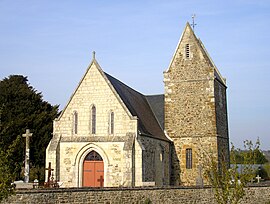
Back Combray (Calvados) AST Combray Breton Combray Catalan КомбгӀе (Кальвадос) CE Combray CEB Combray German Κομπραί (Καλβαντός) Greek Combray Esperanto Combray Spanish Combray (Calvados) Basque
Combray | |
|---|---|
 The church in Combray | |
| Coordinates: 48°57′00″N 0°26′17″W / 48.95°N 0.4381°W | |
| Country | France |
| Region | Normandy |
| Department | Calvados |
| Arrondissement | Caen |
| Canton | Le Hom |
| Intercommunality | Cingal-Suisse Normande |
| Government | |
| • Mayor (2020–2026) | Roger Havas[1] |
Area 1 | 4.51 km2 (1.74 sq mi) |
| Population (2022)[2] | 143 |
| • Density | 32/km2 (82/sq mi) |
| Time zone | UTC+01:00 (CET) |
| • Summer (DST) | UTC+02:00 (CEST) |
| INSEE/Postal code | 14171 /14220 |
| Elevation | 88–230 m (289–755 ft) (avg. 187 m or 614 ft) |
| 1 French Land Register data, which excludes lakes, ponds, glaciers > 1 km2 (0.386 sq mi or 247 acres) and river estuaries. | |
Combray (French pronunciation: [kɔ̃bʁɛ] ⓘ) is a commune in the Calvados department in Normandy in north-western France.[3] The commune is part of the area known as Suisse Normande.[4]
Combray is also an imagined village in Marcel Proust's À la recherche du temps perdu (In Search of Lost Time), a book which was strongly inspired by the village of his childhood, Illiers, which has now been renamed Illiers-Combray in his honor. Combray is the title of the first part of the first volume of À la recherche du temps perdu, titled Du côté de chez Swann (Swann's Way).
There is a medieval motte-and-bailey castle.[5]
- ^ "Répertoire national des élus: les maires". data.gouv.fr, Plateforme ouverte des données publiques françaises (in French). 9 August 2021.
- ^ "Populations de référence 2022" (in French). The National Institute of Statistics and Economic Studies. 19 December 2024.
- ^ Combray sur le site de la communauté de communes Archived 2010-07-31 at the Wayback Machine
- ^ "Map of Suisse Normande" (PDF).
- ^ Arcisse de Caumont, Statistika monumentalne Calvados


